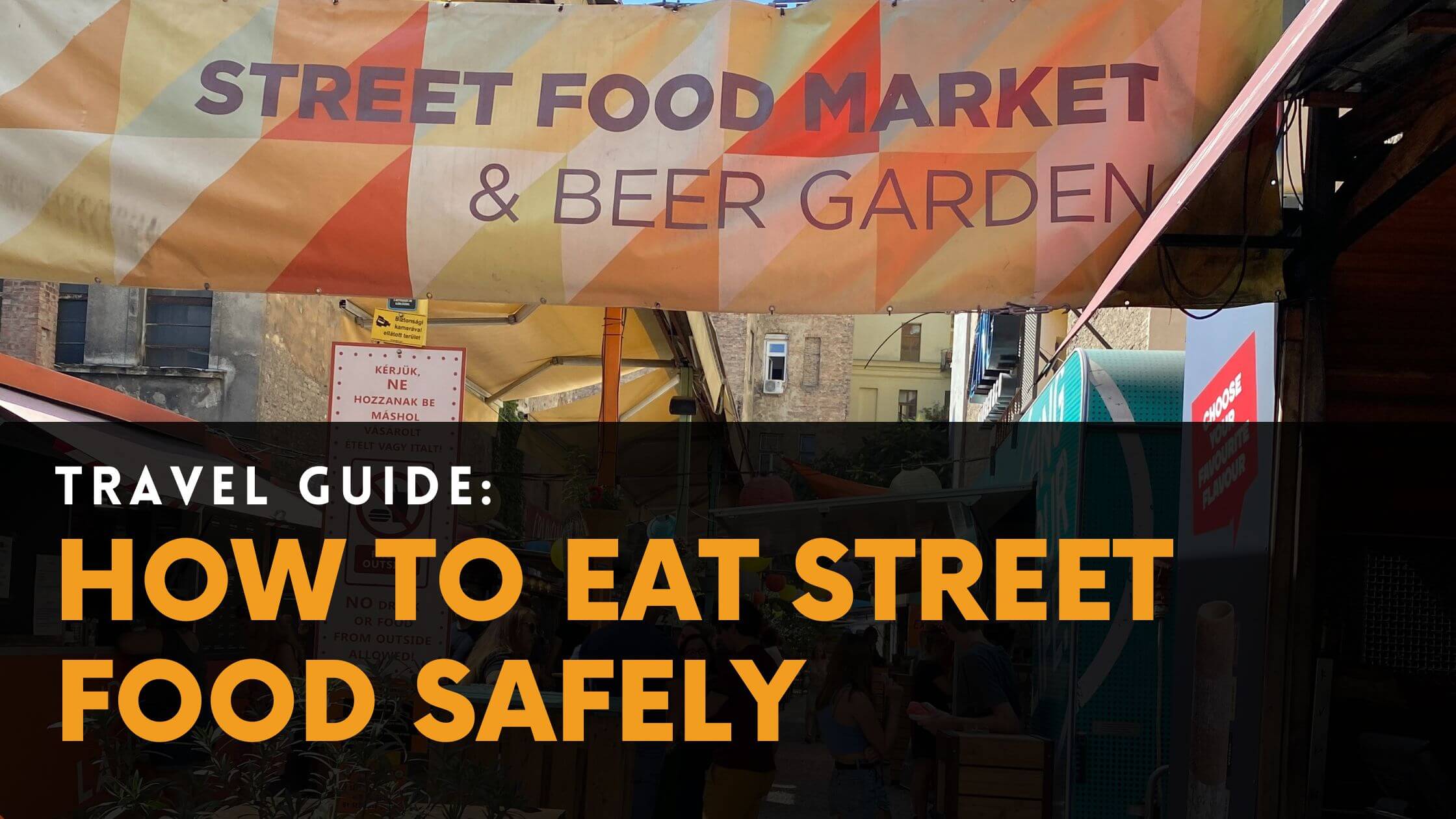Whether or not you’re on a brief time period or long run journey, having fun with native avenue meals is a tremendous manner to hook up with the native tradition and avoid wasting money. That mentioned, you’ve doubtless heard the tales from associates/household/friends-of-friends about their meals poisoning experiences from avenue meals throughout their very own travels..
With this in thoughts, and my very own experiences, I wished to share a useful information on find out how to eat avenue meals safely; offering you ideas and tips and allow you to benefit from the distinctive perception into native cultures whereas additionally being protected throughout exploring the native avenue meals scene.
Find out how to eat avenue meals safely whereas travelling
I completely get it, being holed up for 3-days feeling wretched and caught solely consuming water throughout your journey is an terrible expertise. Fortunately (to this point *contact wooden*) I’ve solely had a few points from what I’ve consumed whereas travelling.
To assist with you subsequent journey, it’s price maintaining these recommendations on find out how to safely eat avenue meals whereas travelling in thoughts:
Look out for busy distributors with excessive numbers of punters
A busy queue filled with locals ready to be served is an efficient indicator a vendor is standard and a terrific alternative to eat like an area. This isn’t to say empty distributors don’t/gained’t provide superb meals experiences, however, if different vendor(s) close by are busy and ‘your’ one isn’t it’s price contemplating why.
Another excuse to look out for busy distributors is the meals is extra prone to be contemporary. Meals distributors with a excessive turnover of shoppers can be having to prepare dinner extra and wish to switch their elements every day (if not much more steadily), nevertheless, these which are much less busy will attempt to use the day gone by(s) elements once more…which in come locations the place refrigeration circumstances are poor generally is a trigger for alarm.
Test the hygiene of the seller and surrounding space
It’s all the time good to go searching and meander by meals stalls, this isn’t simply an opportunity to see what you fancy to eat but additionally to overview hygiene distributors and the encompassing space. Test to see that distributors are dealing with meals safely – avoiding cross contamination – and cleanliness of the stalls.
Keep away from consuming uncooked or undercooked meats and meals
Uncooked or undercooked meals can carry dangerous micro organism and even parasites, and should you’ve ever had undercooked hen earlier than you’ll know the aftermath. With this in thoughts, it’s greatest to keep away from uncooked or undercooked choices when attempting avenue meals; this goes for seafood simply as a lot as meats.
Follow properly cooked, scorching, and contemporary dishes the place attainable as this provides you the most effective likelihood of not selecting up a nasty abdomen bug. Nonetheless, additionally make sure you belief your sense of scent and if it tastes or smells off discard it.
Keep away from contemporary dairy the place you possibly can
In case you’ve ever left the milk out on a heat day you’ll know simply how shortly it could possibly flip bitter. For comparable causes it’s greatest to keep away from contemporary dairy when consuming at meals vendor stalls, as it may be onerous for them to maintain it chilled and forestall dangerous micro organism from creating within the dairy.
Fortunately, a number of distributors use UHT, pasteurised, or condensed milk when utilizing dairy in dishes, which is heated to excessive temperatures to kill off micro organism and is okay to eat.
Make vegetarian meals your desire
Some international locations, comparable to India, have fairly vegetarian diets as a consequence of cultural and spiritual causes, with meat choices reserved for guests or particular events. As such, this will imply meat and dairy are left sitting round for prolonged durations of time till it’s lastly cooked, and probably result in many points must you eat poorly saved, ready, and cooked “outdated” meats.
When you find yourself in an space that has much less of a meat food regimen, it is a nice alternative to pattern native vegetarian delicacies and actually immerse your self within the native meals scene.
Be aware of the water used for cooking and washing
Contaminated and unsafe faucet water generally is a main reason for diseases when travelling. With international locations having completely different ranges of sanitation and varieties of pathogens current, it’s essential to be aware of the water used for cooking and washing meals.
In case you’re uncertain if the faucet water in your vacation spot is protected, it’s greatest to stay to bottled water, test your embassy steering for journey within the space, and even use apps comparable to FaucetSafe to get an concept on the water high quality the place you might be.
Nonetheless, when shopping for bottled water, make sure you test the seals on the bottle earlier than buying and taking a sip. Although unlikely, it’s attainable the bottle has been tampered with or refilled utilizing native faucet water to chop prices.
In case you’re uncertain both of the native faucet water or the power to purchase protected bottled water (or wish to rescue your plastic waste), it’s price investing in a water bottle with a filtration system. With among the finest being the LifeStraw Go 1L bottle and filter.
Cross on contemporary salads and unpeeled fruits
For comparable causes to avoiding faucet water, contemporary salads and elements ought to be averted in any respect prices, as they’re prone to have been washed and ready utilizing faucet water. These cleansing processes can contaminate the elements with unsanitary water and result in a world of points…and contains mint or different garnishes for cocktails.
Equally, it’s greatest to keep away from unpeeled vegetables and fruit when travelling as (once more) they’ve doubtless been washed or ready utilizing faucet water, nevertheless, if the ingredient is peeled there’s much less prone to be any contamination.
Keep away from ice in drinks
Ice is the bug bear for thus many individuals when travelling, resulting in abdomen points and probably a ruined journey in simply a few sips from a contaminated drink. Except the ice is filtered (sometimes appears to be like prefer it has been sliced and is available in skilled packaging), it’s greatest to keep away from ice in its entirety when attempting avenue meals meals and drinks.
Belief your sense of scent
Earlier than taking a chunk or sip, take a whiff of what you’ve ordered and choose whether or not it smells proper to you. If the meals or drink doesn’t scent fairly proper than bin it, it’s manner higher to lose a few quid than must spend days on a rest room and damage your complete journey.
Use your senses and commonsense, don’t damage your journey by ignoring one thing that doesn’t look, scent or really feel proper.
Preserve your hand hygiene properly maintained
Although avenue distributors take the brunt of individuals on the lookout for somebody/one thing guilty if somebody will get sick after visiting them, it’s not all the time their fault. Micro organism and viruses can simply unfold (hell, we simply had 2+ years experiencing this globally) so it may very well be that you simply received/get sick from not practising your personal hygiene.
Make sure you wash your arms steadily and earlier than you deal with your meals, utilizing hand rubs or cleaning soap and clear water to keep away from making your self unwell. Moreover, you nails can decide up heaps of dust while you journey, make sure you hold them neat and tidy to keep away from carrying pathogens round.
Use apps and maps to seek out avenue meals hubs
The place there’s avenue meals there’s prone to be exercise. Utilizing Google Maps or Foursquare you possibly can monitor down the busiest locations in a metropolis or vacation spot, sometimes these can be in fairly foodie areas and near markets or native points of interest and workplaces.
Different methods to seek out nice avenue meals is to make use of Foodspotter, Yelp, researching native meals bloggers and even heading to instagram to see what’s below the road meals hashtags in your chosen vacation spot.
Get native (and fellow traveller) suggestions
Personally, I like to talk with the employees once I get to a hostel/lodge and see what meals locations they suggest and revel in going to – even higher when they’re locals and grew up within the space. Equally, if I am going on a walking tour I’ll attempt to have a chat with the information(s) and see the place they suggest going.
Alternatively, you may get good ideas from different travellers who’ve already been exploring the world, usually they’ll be eager to share what they’ve discovered and provides recommendations on the place to go and the place to keep away from.
Get it made contemporary
It may be tempting to simply take what you’re given and never trigger a scene when ordering, however with well being at stake it’s all the time price checking and asking on your order to be made contemporary and in entrance of you. You by no means know the way lengthy elements have been sitting there or what has touched them while they’ve waited for use, and in the event that they refuse, you possibly can simply stroll away.
An excellent instance of that is at burger stands that prepare dinner uncooked meals near/in the identical space as cooked meals, heightening the probabilities of cross contamination or resulting in your order being dry and overdone.
Take pleasure in exploring the road meals scene
I get it, the quantity and variation of ideas within the submit make it appear to be you’re inevitably going to get sick. Nonetheless, should you observe the following pointers and use your widespread sense and senses, you’ll be simply positive and be capable of have a tremendous time sampling native cuisines and delicacies.
Experiencing the colourful meals cultures in locations is a very nice technique to get to know and discover a spot, so see avenue meals and their native bites as a part of the enjoyable, with being wise and good a part of the journey.
Hopefully this submit and information provides you the instruments to take pleasure in essentially the most unimaginable avenue meals experiences. In case you’re after additional info on staying wholesome while travelling, go to Fit For Travel which supplies a terrific listing of issues to look out for and contemplate when travelling.
In case you have any extra ideas you want to share, please do let me know by including them within the feedback. I really like to listen to from you about your experiences and ideas, and it’s even higher once I can share these with others.
Take a look at my associated posts for extra packing and planning recommendation and guides:







